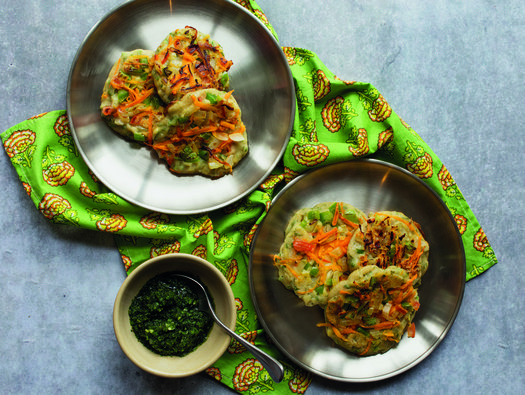Semolina uttapam

It is usually made using dosa batter from rice and lentils, but this recipe is an instant alternative, which requires no grinding and fermenting to make the batter.

It is usually made using dosa batter from rice and lentils, but this recipe is an instant alternative, which requires no grinding and fermenting to make the batter.
120g coarse semolina (rava/suji)
75ml plain yoghurt
100-120ml water
2 tablespoons fresh coriander, finely chopped
2 teaspoons cumin powder
2.5cm piece of ginger (15g), finely grated
2 green chillies, finely chopped
½ onion, finely chopped
1 small green pepper, finely chopped
40g carrot, grated
½ small tomato (50g), finely chopped
30g fresh coriander, chopped
2 tablespoons fresh mint leaves, chopped
2 green chillies
2 garlic cloves
1 teaspoon lime juice
1 teaspoon sugar
2-3 teaspoons water for grinding
In a large bowl mix the semolina and yoghurt. Add 100ml water and mix well. Rest mixture for 15 minutes to allow semolina to absorb some of the water.
Add the chopped coriander, cumin powder, grated ginger and finely chopped green chillies. Adjust consistency by adding another 1-2 tablespoon(s) of water if needed.
In a separate bowl, prepare the vegetable topping by mixing the finely chopped onion, green pepper, tomato and grated carrot.
Put a pan onto a medium heat. Spread a drop of oil in the pan to avoid the uttapam sticking. Pour a big tablespoon of the semolina mixture in the pan. Add the vegetable toppings and press gently. Spread ¼ teaspoon oil around the uttapam. You can make 4-5 small uttapams at the same time, depending on the pan’s size. Cover and cook for a minute or until the base is cooked well. Flip over and cook the other side.
Grind chutney ingredients to a smooth paste in a blender. Add only 1-2 teaspoons water to avoid making the chutney too thin.
Serve uttapams warm, with the fresh chutney.
The semolina is the main source of carbohydrate in this recipe. The value has been provided if you have been trained in insulin adjustment.
Despite the use of some high-potassium ingredients, this recipe is low in potassium, when following the quantities and serving sizes given, so is suitable if you have been advised to reduce the amount of potassium in your diet. It is also low in phosphate; however, it does contain some phosphate, mainly provided by the yoghurt and semolina, so if you have been prescribed a phosphate binder, take as directed.
This recipe is low in protein, and suitable for people advised to eat less protein. If you have been advised to eat more protein, consider eating additional protein in another meal of the day.
Low in protein and high in fibre, this recipe is best eaten freshly made, although the coriander and mint chutney can be stored in airtight container and refrigerated for three days or frozen.
By giving us your email address, you're giving us permission to send you the latest news from Kidney Care UK. Further information about how we protect and use your personal data is available in our Privacy policy. If you would like to change the way we communicate with you at any time please email [email protected]. You can unsubscribe at any time by using the link at the bottom of every email we send.